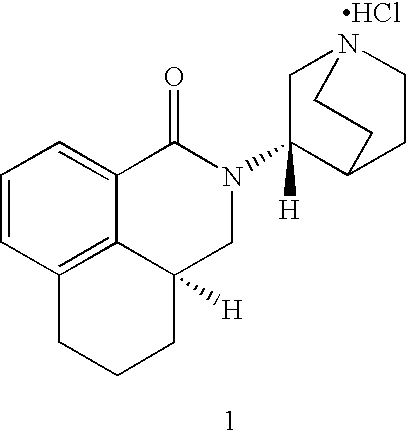Method of treating post operative nausea and vomiting
a post-operative nausea and vomiting technology, applied in the field of post-operative nausea and vomiting, can solve the problems of patients' anxiety about undergoing further surgery, severe side effects, and dehydration, and achieve the effect of improving potency
- Summary
- Abstract
- Description
- Claims
- Application Information
AI Technical Summary
Benefits of technology
Problems solved by technology
Method used
Image
Examples
example 1
Prevention of PONV Using a Single Intravenous Dose of Palonosetron
[0068] A study was conducted to test the efficacy and safety of five doses of intravenously administered palonosetron for the prophylaxis of postoperative vomiting and nausea. A total of 381 women, 24-80 years of age, scheduled for abdominal or vaginal hysterectomy and having ASA physical status rating of I or II were enrolled in this study. All patients received balanced general anesthesia, including N2O plus an opiate. Study medication, palonosetron, was administered over 30 seconds through a peripheral IV line at skin closure at the conclusion of the surgical procedure.
TABLE 124 Hours After Recovery - IV (Evaluable patients)Placebo o0.1 μg / kg0.3 μg / kg1.0 μg / kg3.0 μg / kg30 μg / kg(n = 62)(n = 47)(n = 67)(n = 62)(n = 67)(n = 67)% with CR*19%34%34%44%30%45%p-Valuea—N / Ab0.0510.0040.1740.002% with CC**19%34%33%44%30%45%p-Valuea—N / Ab0.0750.0040.1740.002Time to3.36.09.619.57.315.0Failure (hr)(median)***p-Valuea—N / Ab0.0050...
example 2
Oral Administration of Palonosetron to Treat PONV
[0076] A study was performed to test the efficacy, safety, and pharmacokinetics of five doses of orally administered palonosetron for the prophylaxis of postoperative vomiting and nausea. Three hundred fifty-one patients, 308 women and 43 men, 19-75 years of age, scheduled for elective laparoscopic surgical procedures and having an ASA physical status rating of I and II were enrolled in this study. All patients received balanced general anesthesia, including NO2 plus an opiate.
[0077] Doses of palonosetron were calculated based on thee patient's body weight at the screening visit, rounded to the nearest kilogram. Each dose was diluted to a total volume of 25 mL by adding sterile water to the dosing cup. The dosing cup was rinsed with 25 mL of sterile water and the patient also swallowed this 25 mL. Study medication was administered 2 hours prior to scheduled induction of anesthesia for surgeries requiring nasogastric suction and 1 ho...
example 3
Intravenous Formulation
[0087] Table 8 below presents a representative formulation of palonosetron formulated for intravenous administration.
TABLE 8Representative IV FormulationIngredientWeight Parts (mg / ml)Palonosetron Hydrochloride0.05Mannitol41.5EDTA0.5Trisodium citrate3.7Citric acid1.56WFJ1.0Sodium hydroxide solution and / orpH 5.0 ± 0.5hydrochloric acid solution
PUM
| Property | Measurement | Unit |
|---|---|---|
| concentration | aaaaa | aaaaa |
| concentration | aaaaa | aaaaa |
| half life | aaaaa | aaaaa |
Abstract
Description
Claims
Application Information
 Login to View More
Login to View More - R&D
- Intellectual Property
- Life Sciences
- Materials
- Tech Scout
- Unparalleled Data Quality
- Higher Quality Content
- 60% Fewer Hallucinations
Browse by: Latest US Patents, China's latest patents, Technical Efficacy Thesaurus, Application Domain, Technology Topic, Popular Technical Reports.
© 2025 PatSnap. All rights reserved.Legal|Privacy policy|Modern Slavery Act Transparency Statement|Sitemap|About US| Contact US: help@patsnap.com

